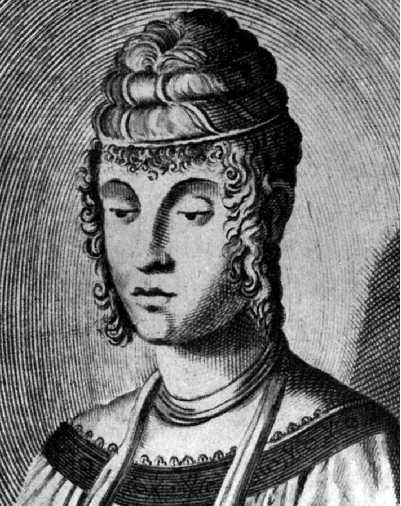Venetian humanist, writer, and scholar Cassandra Fedele was born to citizen-class parents, Angelo Fedele and Barbara Leoni, in Venice. Schooled in Greek and Latin grammar by her father, she studied philosophy, the sciences, and dialectics with the noted scholar of classical literature and Servite friar, Gasparino Borro. When she was sixteen she joined an active circle of scholars at the University of Padua, among whom were Niccolo Tomei, then the leading Aristotelian at the university; the Rimini-born scholar Giovanni Aurelio Augurello; the Brescian theologian Bonifacio Bembo; Panfilo Sasso from Modena; Gian-francesco Superchio of Pesaro, who was known as Filomuso; and the Paduan painter, sculptor, and philosopher, Girolamo Campag-nola. Primed by her regular discussions with such academics as these, Fedele delivered her first public oration at her cousin Bertucio Lamberti’s baccalaureate ceremony at the University of Padua in 1487. This speech was immediately published in three printed editions, each titled Oratio pro Bertucio Lamberto (Modena 1487; Nuremberg 1488; Venice 1489). Soon afterward, at the invitation of the philosopher Giorgio Valla, she presented a second public lecture before the doge, Agostino Barbarigo, and the Venetian senate, in which she praised the study of literature and addressed the practical question of higher education for women. Her major work, Epistolae et orationes, which contained not only all her public lectures but her one hundred and twenty-one Latin letters, circulated widely in manuscript in Italy, though it failed to find a readership north of the Alps until 1636, when it was published posthumously by the Paduan printer Bolzetta.

Cassandra Fedele, Venetian humanist, writer, and scholar. Anonymous engraving from Epistolae & Orationes Posthumae. (Maria Bandini Buti, Enciclopedia bi-ografica e bibliografica italiana: poetesse e scrittrici)
With the publication of the Oratio pro Lam-berto, Fedele’s reputation as humanist scholar and writer spread beyond the Veneto to Florence, Ferrara, Milan, Germany, and Hungary. Through the Florentine Hellenist Angelo Poliziano, who met her inVenice around 1490, Fedele entered into correspondence with members of Lorenzo de’ Medici’s circle, exchanging letters not only with Poliziano but also with Pico della Mirandola, the chancellor of Florence Bartolomeo Scala, and Scala’s daughter Alessandra, who was also a scholar of Greek. Her correspondence with the members of both her Paduan and her Florentine circles exemplifies the humanist themes typical of her era: the elevation of reason (ratio) to quasi divine status; the supremacy of eloquence among human pursuits; the civilizing role of the study of the liberal arts (studia humanitatis); the role of the writer as a cultural critic and prophet of sorts (vates); and lastly the idealization of the patronage relationship as a sublime bond between intellectual and moral peers (amicitia). Though Fedele wrote in the cultivated Latin of Cicero, Seneca, and Pliny the Younger, her rhetorical style is self-consciously framed and embellished as female. She defines herself in terms of her sexual innocence and her “natural” feminine weaknesses, in both intellectual and physical terms (Robin 2000, 8-9; Robin 1995).
Fedele’s letters to and fTom Italian and European royalty and other nobles showcase her expertise in the Ciceronian language of patronage. These letters reflect her repeated attempts to win a court appointment with an annual stipend and to offer her literary services to such prospective patrons as these. She exchanged letters with Duchess Beatrice d’Este of Milan, Queen Beatrice d’Aragona of Hungary, Duchess Eleonora d’Aragona of Ferrara, Marchese Francesco Gonzaga of Mantua, King Louis XII of France, Duke Lodovico Sforza of Milan, and Christopher Columbus’s patron, Queen Isabella of Castile, who tried unsuccessfully for the better part of a decade to persuade Fedele to join her court in Spain (1487-1485).
By the end of the 1490s, Fedele was the best-known female humanist in Europe. Her storied literary career, recounted in every early modern Italian catalogue of famous women, overshadowed that of her fellow humanists Isotta Nogarola and Laura Cereta. But what was recorded both about Fedele’s writings and her personal life was largely a fiction. The biographical tradition praised the beauty of her Latin poetry and attested to her having written a book entitled Ordo scientiarum (The Order of the Sciences). But no trace of her alleged book or poems has surfaced. Well into the seventeenth century the early biographical catalogues characterized Fedele as a lifelong virgin. But, in fact, Fedele married Gian-Maria Mappelli, a physician from Vicenza, in 1499, and she lived with him until his death in 1521. Little is known about their marriage, though two tantalizing letters survive in which Fedele addresses an unnamed physician in unusually intimate terms (Robin 2000, 40-41). In the summer of 1515 Fedele and Mappelli set sail for Retima, Crete, where he practiced medicine for five years. The couple resettled in Venice in 1520 after nearly losing their lives in the storm that sank their ship on their return voyage to the mainland. They survived, but with nothing but the clothes on their backs. Widowed the same year that the couple returned to Venice, Fedele spent the 1520s and 1530s desperately looking for employment as a writer or teacher, but with no luck. As an elderly, single, female scholar, she no longer received the invitations to lecture that she had enjoyed in her twenties. In 1547, Fedele at last obtained an appointment from Pope Paul III as prioress of the orphanage of San Domenico di Castello in Venice.
Two years before her death, she was invited to give a public oration before the Venetian senate and Doge Francesco Venier in 1556, to commemorate the arrival of Queen Bona Sforza of Poland in Venice. When Fedele died in 1558 at the age of ninety-three, the Venetian senate honored her with a public funeral. She lay in state at the church of San Domenico; her body was placed on a marble bier, her white hair bound with laurel.
Diana Robin
See also Cereta, Laura; Education, Humanism, and Women; Literary Culture and Women, particularly the subheading Letter Writing; Nogarola, Isotta; Querelles des Femmes.
Bibliography
Primary Works
For the early modern catalogues with vitae of Fedele, see Battista Fregosa (aka Cam-pofregosa, 1483), Jacopo Filippo da Bergamo (1497),Jean Tixier de Ravisius (1521), Giuseppe Betussi (1545), Giovanni Battista
Egnazio (1554), Giacomo Alberici (1605), and Jacopo Filippo Tommasini (1644).
No manuscript collections of Fedele’s letters are known; five letters not included in the Tommasini edition are published in Capelli, Cavaz-zana, Pesenti, and Petrettini (cited in Secondary Works).
Fedele, Cassandra. Clarissimae Feminae Cassandrae Fidelis Venetae Epistolae et Orationes. Edited by Giacomo Filippo Tommasini. Padua: Franciscus Bolzetta, 1636.
Fedele, Cassandra. Letters and Orations. Edited and translated by Diana Robin. Chicago and London: University of Chicago Press, 2000.
Fedele, Cassandra. Oratio pro Bertucio Lamberto. Modena: 1487;Venice: 1488; Nuremberg:
1489.
King, Margaret L., and Albert Rabil, Jr., eds. Her
Immaculate Hand: Selected Works by and About the Women Humanists of Quattrocento Italy. Binghamton, NY: Medieval and Renaissance Texts and Studies, 1983. (Second revised paperback edition in 1991.)
Secondary Works
CapeIIi, Adriano.“Cassandra Fedele in relazione con Lodovico II Moro.” Archivio Storico Lombardo 3, no. 4 (1895): 387-391.
Cavazzana, Cesira.“Cassandra Fedele erudita
Veneziana del Rinascimento.” Ateneo Veneto 29, no. 2 (1906): 73-79, 249-275, 361-397.
Pesenti, G. “Lettere inedite del Poliziano.” Athenaeum 3 (1915): 299-301.
Petrettini, Maria. Vita di Cassandra Fedele. Venice: 1814. (Reprinted in 1842.)
Robin, Diana.“Cassandra Fedele (1465-1499).” In Italian Women Writers: A Bio-Bibliographical Sourcebook. Edited by Rinaldina Russell, 119-127.Westport, CT: Greenwood Press, 1994.
Robin, Diana. “Cassandra Fedele’s Epistolae (1488-1521): Biography as Effacement.” In The Rhetorics of Life-Writing in Early Modern Europe: Forms of Biography from Cassandra Fedele to Louise XIV. Edited by Thomas Mayer and Daniel Woolf, 187-203.Ann Arbor: University of Michigan Press, 1995.




 World History
World History









